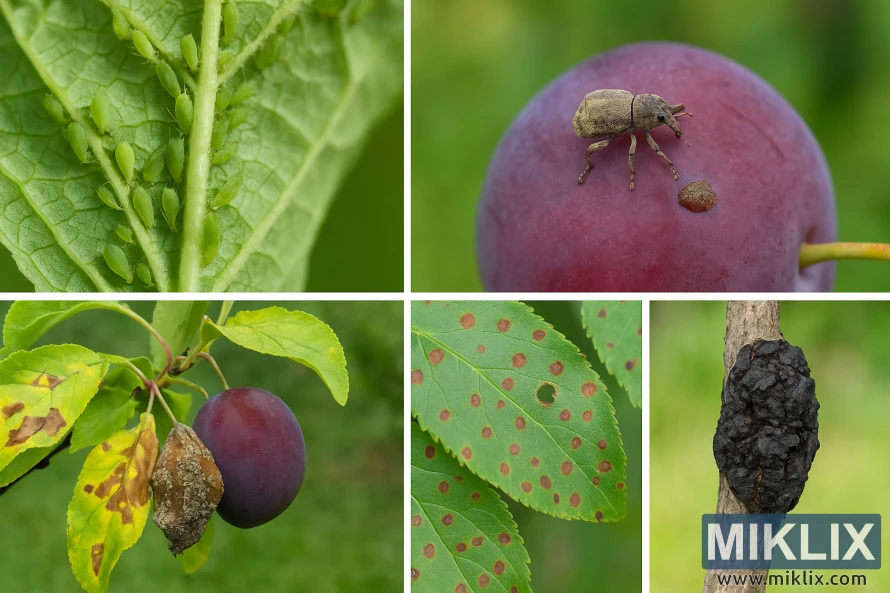Image: Common Plum Tree Pests and Diseases
Published: September 13, 2025 at 11:00:00 PM UTC
A high-resolution collage showing aphids, plum curculio, brown rot, shot hole disease, and black knot on plum trees for clear visual comparison.
The image is a high-resolution landscape-oriented photo collage showing five common plum tree pests and diseases, arranged in a clean grid format that allows for clear visual comparison. Each panel highlights a different threat, captured in sharp focus and natural daylight to emphasize the identifying details of the insects, fungi, and leaf or fruit damage they cause. The consistent bright green and reddish color palette of healthy plant tissue contrasts vividly with the damage and pests, making the symptoms immediately apparent.
Top left: A close-up macro shot shows a cluster of aphids congregating along the midrib of a young plum leaf. The aphids are tiny, soft-bodied, and bright green, with pear-shaped forms and long, slender legs and antennae. They cling tightly to the underside of the leaf, their mouthparts inserted into the tissue to suck sap. The leaf surface around them looks slightly puckered and distorted, a sign of feeding damage.
Top right: A detailed shot shows an adult Plum curculio beetle on the surface of a ripening plum fruit. The beetle is small, with a mottled brown-gray coloration and a distinctive long curved snout. It stands near a tiny crescent-shaped scar on the fruit’s skin, the hallmark oviposition mark where the female has laid an egg. The fruit’s smooth, red-purple skin contrasts sharply with the beetle’s rough, textured body.
Bottom left: This panel captures the effects of Brown rot on fruit and foliage. One plum fruit is shriveled and covered with tan-gray fungal spores, while an adjacent healthy fruit still appears plump and smooth. The surrounding leaves show yellowing and browning along their margins. The fungal infection clearly differentiates the diseased fruit from the healthy one, showing how brown rot spreads.
Bottom center: A close view of plum leaves affected by Shot hole disease displays numerous small, round brown lesions. The dead tissue has fallen out from some spots, leaving neat circular holes. The green leaf tissue between lesions is intact, making the shot-hole pattern distinctive and easily recognizable.
Bottom right: A macro shot of a branch shows a dark, swollen, rough-textured growth caused by Black knot. The knot is hard, coal-black, and elongated, encircling the twig and distorting its shape. The surrounding bark is healthy brown, highlighting the dramatic contrast.
The image is related to: The Best Plum Varieties and Trees to Grow in Your Garden

